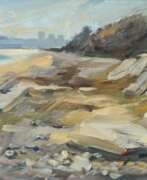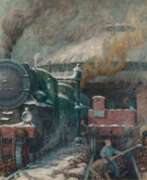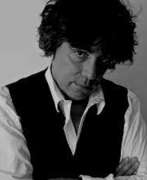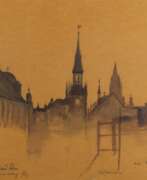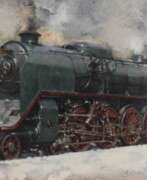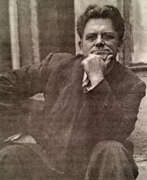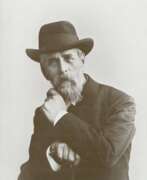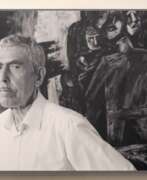Industrial landscape Realism


Aleksey Kuzmich Denisov-Uralsky (Russian: Алексей Кузьмич Денисов-Уральский) was a Russian artist and stonecutter, born in 1864 and known for his exceptional landscape paintings and intricate stone carvings. He made significant contributions to both the artistic and jewelry worlds, particularly in Russia during the late 19th and early 20th centuries.
Denisov-Uralsky's works are celebrated for their meticulous craftsmanship and vibrant use of color. His paintings often depicted the serene landscapes of the Ural Mountains, capturing their natural beauty with a delicate touch. Notable pieces include "River Landscape" and "Author's Boat by the High Wooded Bank of the Chusovaya," both of which have fetched impressive prices at auctions, reflecting their enduring appeal.
In addition to his paintings, Denisov-Uralsky was renowned for his work with semi-precious stones. He founded a prominent firm in St. Petersburg, where he created exquisite jewelry and decorative items. One of his famous works, an imperial hardstone figure of a parrot, showcases his ability to transform natural stones into lifelike sculptures. This piece was even purchased by Dowager Empress Maria Feodorovna, underscoring its high value and artistry.
Collectors and art enthusiasts continue to admire Denisov-Uralsky's legacy, which combines the elegance of Russian landscapes with the precision of fine stonework. His works remain sought after at auctions and are displayed in various prestigious collections worldwide.
For updates on new product sales and auction events related to Aleksey Kuzmich Denisov-Uralsky, sign up for our notifications. Stay informed about opportunities to acquire pieces by this exceptional artist.


Don Eddy is a contemporary representational painter. He gained recognition in American art around 1970 amid a group of artists that critics and dealers identified as Photorealists or Hyperrealists, based on their work's high degree of verisimilitude and use of photography as a resource material. Eddy has worked in cycles, which treat various imagery from different formal and conceptual viewpoints, moving from detailed, formal images of automobile sections and storefront window displays in the 1970s to perceptually challenging mash-ups of still lifes and figurative/landscapes scenes in the 1980s to mysterious multi-panel paintings in his latter career. Eddy's work has been informed by wide-ranging, sometimes contradictory influences: old masters (e.g., van Eyck and Vermeer), Impressionist and Neo-Impressionist color, the analytical cubism of Braque and Picasso, Hans Hofmann, Conceptual and Minimalist critiques of Abstract Expressionism, and Pop art.


Anton Gutknecht was a German-American landscape painter known for his maritime seascapes of southern California and rural Europe. With a particular interest in the tumultuous nature of the ocean, the artist often focused on capturing waves crashing on the shore or on the boughs of a ship rendered in a high level of realistic detail. Gutknecht spent his early life traveling between different areas of the country, notably Munich and Hamburg, observing the mountainous terrain that would later be the focus of his work and bring him recognition. Gutknecht taught at the Royal Academy in Vienna before frequently traveling to southern California in the 1930s, eventually moving there to settle in Palm Springs and focus on capturing the landscape there.


Han Hsiang-ning is a Taiwanese-American artist. Han has participated in many prominent museum exhibitions. He often uses spray painting and paints photo-realistic street scenes. In 1961, he joined the "Fifth Moon Group". He began abstract form oil painting, and his works first appeared in the magazine Pen Review. In 1963 he began working with roller and stencils on rice paper, still abstract, emphasizing form and space structure. In 1969 he began spray painting works using acrylic paint on canvas, created the "Invisible Image" series. In 1971, in the process of spray gun painting, found how to create different combinations of sprayed color dots, a form of pointillism. In 1971 he continued the spray gun technique, but began using New York city-scenes as a subject and his camera as sketching tool. In 1972 he launched studies on industrial scenes with vivid images. He completed his first self-portrait in 1981. In 1983 he began using brushes to paint watercolor and ink on paper. His subjects being street crowds and bird's eye views of intersections of New York streets.


Fritz Kreidt was a German painter. He was a member of the Künstlersonderbund, an association of German artists committed to realism.
Coming from university, Kreidt's early works were rather abstract, but he soon turned to a more figurative style of representation. He finally found his main subject in melancholic-looking landscape depictions - often industrial wastelands or building sites - which, although often deserted, bear witness to human labour and its transience. Since the year of German reunification in 1990, Kreidt has been concerned with industrial and urban landscapes of the former GDR.
In 2005, Kreidt went on a study trip to China, which inspired him to create the series "Chinese Landscapes". In these works, deviating from his usual technique of oil painting, he often used conté and coloured pencils, with which he rendered architectural and landscape elements in fine strokes in a manner more oriented towards graphic art.




Ivan Nikolayevich Shulga (Russian: Иван Николаевич Шульга) was a Ukrainian Russian and Soviet artist of the first half of the twentieth century. He is known as a master of painting and drawing and a teacher. His name is included in the "Unified Art Rating of the world's 10,000 best artists" and in the list of the 100 most outstanding artists of Ukraine.
Ivan Shulga worked in different genres: he painted portraits, genre paintings, landscapes (marine, landscape, architectural, industrial), created still life paintings, panels, drawings for art postcards, political posters. His artistic legacy also includes pictures in the genre of nude and historical genre. The artist also illustrated magazines and books, designed theatrical sets.
Shulga worked in watercolor, pencil drawing, gouache, ink and sanguine, pastel, oil and tempera painting.


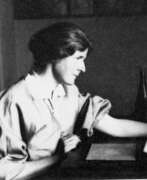

Jessie Constance Alicia Traill was an Australian printmaker. Trained by Frederick McCubbin at the National Gallery of Victoria Art School, and by painter and printmaker Frank Brangwyn in London, Traill worked in England and France in the period immediately preceding World War I. During the war she served in hospitals with the Voluntary Aid Detachment. Traill is best known for a series of prints created in the early 1930s depicting the construction of the Sydney Harbour Bridge. Critic and art historian Sasha Grishin describes her as "one of the great Australian artists of the 20th century".
